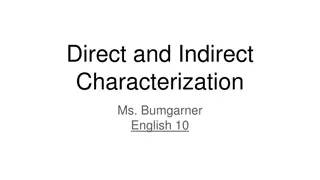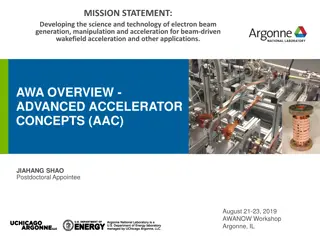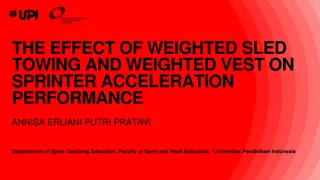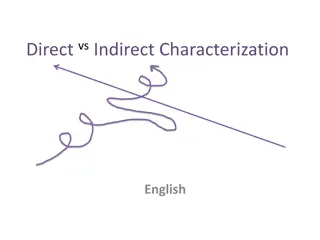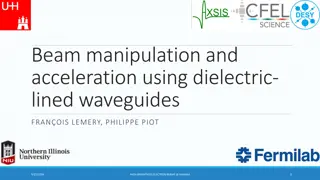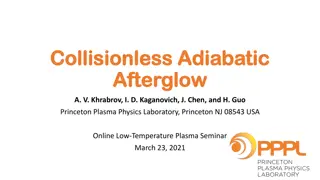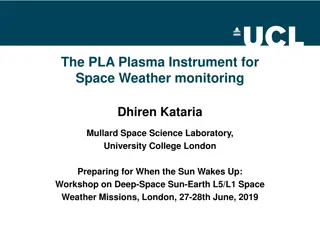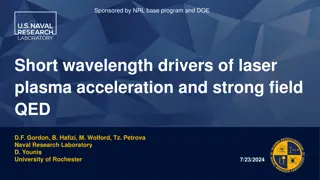Plasma Acceleration and Betatron Oscillations Beam Characterization Method
The method for evaluating the quality of beams accelerated through plasma acceleration and betatron oscillations involves non-intercepting diagnostics to infer information about the electrons while inside the accelerating structure. It includes measuring the rms emittance and correcting the betatron spectrum for X-ray absorption. Techniques such as the least square algorithm are employed for beam profile retrieval and angular distribution assessment, ensuring accurate characterization of the accelerated electron beams.
Uploaded on Sep 26, 2024 | 2 Views
Download Presentation

Please find below an Image/Link to download the presentation.
The content on the website is provided AS IS for your information and personal use only. It may not be sold, licensed, or shared on other websites without obtaining consent from the author.If you encounter any issues during the download, it is possible that the publisher has removed the file from their server.
You are allowed to download the files provided on this website for personal or commercial use, subject to the condition that they are used lawfully. All files are the property of their respective owners.
The content on the website is provided AS IS for your information and personal use only. It may not be sold, licensed, or shared on other websites without obtaining consent from the author.
E N D
Presentation Transcript
Plasma acceleration and betatron oscillations Laser pulse driving the plasma wave In the PWFA the plasma wave Is driven by an electron bunch Self-injection of electrons from the rear of the bubble Cavitation region or ion-bubble where the accelerating/focusing fields develop, up to TV/m Betatron oscillations of the (self)injected electrons How do we check the quality/characteristics of the beams we accelerate?
Motivations Design/conceivement of a non-intercepting diagnostics for plasma accelerated electron beams Infer information about the electrons when they are still inside the plasma accelerating structure Measurement of the rms emittance, comprising the correlation term
First step: beam profile retrievement/1 Algorithm: Least square algorithm looking for the vector P (beam profile) minimizing the norm of the vectorial equation reported below Electron Spectrum Beam Profile Betatron Spectrum Measured betatron spectrum: To be corrected accounting for X-ray absorption before detection Theoretical spectrum: Depending on measured plasma density and electron spectrum For details on the matrix S, see Ref. Curcio, A., et al. "Trace-space reconstruction of low-emittance electron beams through betatron radiation in laser-plasma accelerators." Physical Review Accelerators and Beams 20.1 (2017): 012801.
First step: beam profile retrievement/2 Electron beam radial profile detected (red curve) and simulated (black curve). The blue dashed curves delimit the error region (light green-shadowed). Beam rms size 0.25 0.04 um For the generalization to the 2D case , see Ref. Curcio, A., et al. "Single-shot non-intercepting profile monitor of plasma-accelerated electron beams with nanometric resolution." Applied Physics Letters 111.13 (2017): 133105.
Second step: angular distribution retrievement/1 Beam Profile Correlated angular distribution Transverse Dynamics Correlation function between the angle and the position of a single electron of the beam in the bubble The angular distribution inside the bubble is retrieved starting from the retrieved beam profile ! Relation between the betatron radius and the average electron radial position along the acceleration path
Second step: angular distribution retrievement/2 Angular distribution of the electron beam detected inside the bubble (red curve) . The blue dashed curves delimit the error region (light green-shadowed). Beam rms divergence 13 2 mrad.
Final step: Phase space recontruction Normalized rms emittance (correlated): 0.6 mm mrad Normalized rms emittance (non correlated, upper limit): 1.6 mm mrad
What about the longitudinal phase space?? One idea is that to use a THz streak camera, using betatron radiation to generate photoelectrons, then watching at the energy modulation For THz Streak-Camera, see Ref. : Fr hling, U., Wieland, M., Gensch, M., Gebert, T., Sch tte, B., Krikunova, M., ... & Pl njes, E. (2009). Single-shot terahertz-field-driven X-ray streak camera. Nature Photonics, 3(9), 523.
Retrieval of the longitudinal phase space? Another approach would be analogous to the one used for the retrieval of the transverse emittance, MUTATIS MUTANDIS! Which is now the matrix to invert? First if all, is it possible to find an expression for it? How does the betatron power/spectrum depends on the longitudinal position of the single electrons within the bunch? Work in progress, we are trying to find answer to the questions above
Thanks for your attention alessandro.curcio@cern.ch







